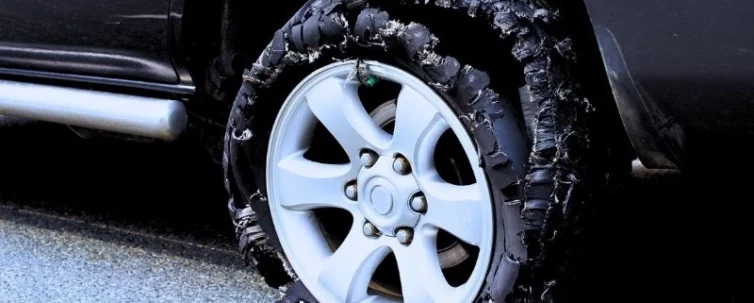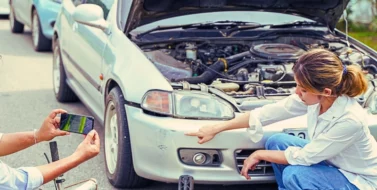After an accident, you may have the question – is a tire blowout an at fault accident? Depending on the cause of the blowout, you may be able to prove that the other driver, a maintenance provider, manufacturer, or seller was at fault for your accident. You may be able to claim compensation for your damages from the person who was at fault.

Table of Contents
What Are the Dangers of a Tire Blowout?
Tire failure car accidents can be deadly on the road. Losing control of the vehicle is one of the most perilous consequences of a tire blowout. Such an incident can cause the car to veer off its course and into other vehicles, or off the road entirely. The debris from a blown-out tire can cause severe damage to your vehicle and other cars on the road.
A driver may also have trouble stopping the vehicle after a blowout, which can be incredibly dangerous, especially when driving at high speed.
Tire Blowouts and At-Fault Accidents
Did a tire blowout cause your crash? If so, it is possible to hold others responsible for your damages. Your attorney must prove that the person or entity was negligent by demonstrating a duty of care was owed to you, the defendant breached that duty of care, and that you suffered damages as a result. For instance, if a driver failed to have his or her tires checked or ignored warnings from a mechanic to replace them, these actions may have fallen below the standard of care.
Determining fault after a tire blowout can be tricky, as there may be multiple defendants. Potential defendants in a tire blowout accident include:
The Other Driver
All drivers have a duty of care to other drivers on the road. Drivers should operate their vehicles responsibly and safely to avoid accidents. To fulfill this duty of care, drivers must also maintain their vehicles and get them serviced regularly. If a driver neglects to take care of a car and its tires, and an accident occurs due to the failure of the tires, the driver may be held responsible for any damages that result.
The Car Maintenance Provider
A tire blowout could be due to a mistake made by the mechanic. This can happen when the tires are either overinflated or underinflated, which increases the likelihood of a blowout. In such a scenario, if the maintenance provider was responsible for servicing your car and failed to properly inflate the tires, he or she could be held accountable for the accident.
Seller or Manufacturer
Tire blowouts can be caused by tire defects. If a tire separation occurs, it can lead to severe injuries and property damage. You can file a product liability lawsuit against the manufacturer and hold them accountable for the defective product. Illinois laws allow for strict liability lawsuits that require showing an actionable defect, causation, and damages.
Fault Classification in Illinois
Illinois follows a fault-based legal system to determine responsibility for damages and injuries resulting from traffic collisions. The driver who caused the accident can be considered at-fault, and be held liable for damages to injured parties through an auto insurance claim or personal injury lawsuit.
To establish fault for a car accident in a personal injury lawsuit, you must prove that a driver was negligent. There are four elements of negligence that you must demonstrate:
- Duty of Care. It is expected that all drivers drive safely and responsibly, as they owe each other a duty of care on the roads.
- Breach of duty. If one of the drivers involved in an accident fails to fulfill this duty of care, he or she is considered to have breached it.
- Causation. The breach of duty by the at-fault driver caused injuries and damages to the victim of the accident.
- Damages. There must be financial or personal losses incurred by the victim due to the accident.
In determining fault, Illinois follows the comparative fault rule. Under this rule, a share of fault is apportioned to both parties. As long as your share of fault is not more than 51% for the accident, you will be able to claim damages for the at-fault driver. However, your damages will be reduced in proportion to your percentage of fault.
An experienced car accident attorney in Illinois can assess the value of your claim based on fault allocation.
The Legal Process in Illinois
Compensation for personal injuries can be resolved in three ways: settlement with the insurance company before a lawsuit, settlement after a lawsuit but before a jury trial, or trial before a jury. Each case is unique and requires a specific strategy. Typically, a lawyer will investigate, identify the defendant, calculate damages, and negotiate or file a lawsuit.
Role of Accident Reports
In the event of an accident, it is essential to notify the police. The police will create an accident report that contains critical information about the case. The police take time to investigate the accident thoroughly by speaking with witnesses, examining the vehicles involved, and taking photographs. The report will also include the opinions of the police inspectors regarding the cause and fault for the crash.
The insurance company will use this report to understand the case, analyze the damage to the vehicles, and determine who is at fault. This information will enable them to estimate the appropriate compensation amount for your claim. It is crucial to obtain the police report as soon as possible and verify that all the facts and statements in the report are accurate. If there are any errors, you can contact the investigating officer to correct them.
Gather Evidence and Documentation
To increase the chances of success in your claim and the amount of compensation you can receive, it is important to have strong evidence. You can start by taking photos or videos of the accident scene, including the weather conditions, the other vehicles involved, your injuries, and any damage to your car. Additionally, you should gather the contact information of any witnesses who saw the accident happen.
You should see a doctor to get a medical record of your injuries and when they occurred. This will help support your compensation claim and link your injuries to the accident. Keep track of all bills and receipts related to the accident, as they will help quantify the damages you claim.
Tips for Preventing and Responding to Tire Blowouts
Tire Care and Maintenance Practices
While tire blowout accidents are sometimes unavoidable, you can take steps to reduce the risk of such accidents.
- It is advisable to have your tires inspected regularly by a professional mechanic.
- Ensure that your tire pressure is correct and that your tires are not over or underinflated.
- Always follow your vehicle’s recommended loading limits to prevent tire damage due to overloading.
- Try to avoid road hazards as much as possible to minimize the risk of tire damage.
- Even if your tires look fine, it is recommended to replace them every six years or after 36 thousand to 75 thousand miles. Keep monitoring tire pressures and overall tire health as well.
What to Do After a Tire Blowout
If you experience a tire blowout while driving, take the following steps to keep control of your vehicle. Stay calm and avoid stepping on the brake. This can cause your wheels to lock up, leading to a total loss of control. Accelerate gently and steer as straight as possible. Slow down by easing your foot from the accelerator. Turn on your emergency lights to signal other drivers. Steer towards the right-hand lane and pull over when it’s safe to do so. After making it safely to the side of the road, assess your tire damage and install your spare or contact roadside assistance.
To safely change your tire, check your surroundings to ensure it is safe to exit your vehicle. Then, set up safety markers such as cones, flags, or road flares to make yourself more visible on the side of the road. Next, remove your damaged tire and install your spare tire. Be aware that the damaged tire will likely be hot right after a blowout. Give it time to cool down before you try to remove it.
After installing the spare tire, use your hazard lights and go slow. Most spare tires are not designed to drive long distances or at high speeds. Use the spare tire to get to a repair or tire shop for a new tire.
In case of a tire blowout accident, call the police, seek medical attention, document the scene, notify your insurance company, and contact a lawyer. These steps will ensure that all bases are covered. Law enforcement can make sure that the accident scene is attended to properly, you get any medical care necessary, and evidence and your legal options are preserved.





